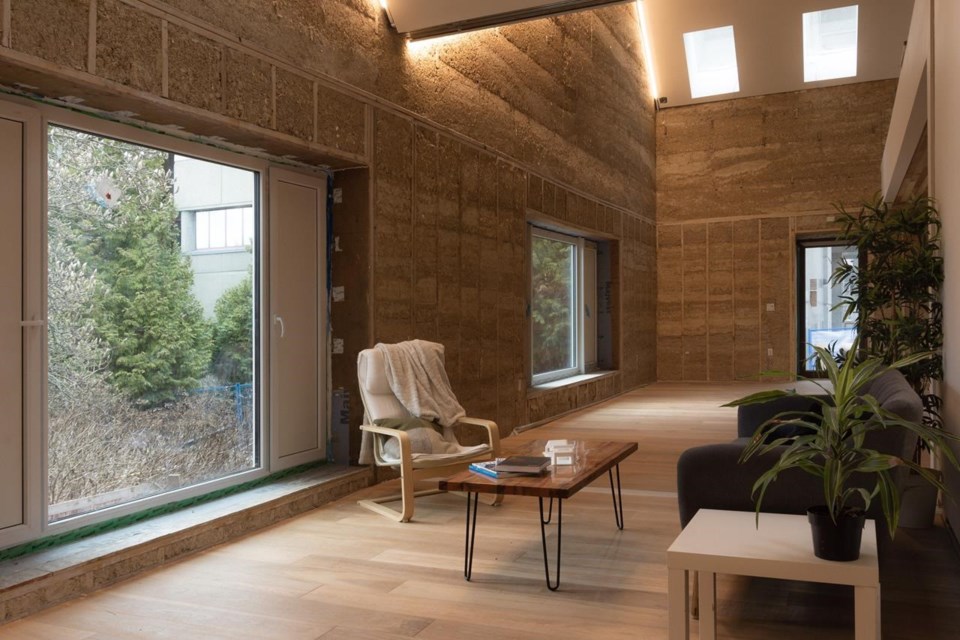VANCOUVER — It has been two years, but University of British Columbia architecture student Katie Theall can vividly recall the"surreal moment" when their team learned it had received a site on the Vancouver campus to build a "carbon-minimal" student space.
"That was sort of a big moment being like, this is our site, this is going to happen," said Theall.
As the project's architecture lead, Theall guided a team of 60 university students from engineering, architecture, business and arts to fundraise $1.85 million and build the hempcrete building on campus — from plans to plaster — all within two years.
Construction workers are putting the final touches on the building this week.
The 222-square-metre building, called Third Space Commons, is one of Canada's first such institutional spaces designed to be near-zero carbon and features a seminar area, a meeting room and a kitchen.
The building is wood framed, while the thermal insulation is made of hempcrete, a mixture of hemp fibres, lime and water, which produces a much smaller carbon footprint than concrete construction, Theall said.
She said the students mixed the hempcrete in a drum, bringing it to the consistency of oatmeal. They then used buckets to pour it into the two-by-four wood frame.
The hemp fibre remains visible inside the building, creating a decorative effect on the wall, although Theall said they will be putting a layer of plaster over the lower portion for protection.
Hempcrete captures carbon from the atmosphere as it sets and eventually turns to a concrete-like material.
“The difference between concrete and hempcrete is pretty distinct. Hempcrete uses agricultural byproducts, it’s a biocomposite. So, it uses agricultural materials rather than things like aggregate,” said Theall.
The University of B.C. said in a statement the foundation of the building is made of reusable steel piles and the team chose light wood framing instead of engineered wood, which is considered more carbon-intensive because of the glues used.
The choice of hempcrete as a building material was deliberate. Theall said her team has been passionate about carbon minimization since the beginning of the project, and they all shared the same mission to reduce the carbon footprint in the construction process.
“Through our research and investigating different materials, we discovered that hempcrete is supposed to be at least carbon neutral or carbon negative, which is why we decided to try to build with it,” said Theall.
Adam Rysanek, an assistant professor at the UBC school of architecture and landscape architecture, said they have had welcome reviews from the public with some calling it "amazing" and "strange."
“I think virtually, there is no concrete in the whole project," said Rysanek, who advised the team on the build.
Hempcrete takes several weeks or months to cure compared with the curing time of days or weeks for concrete, but it comes with advantages such as being highly insulating, fireproof and zero-carbon, said Rysanek.
He said the team worked hard to account for the carbon impact of every element of the project.
The group also recently won an inaugural B.C. Embodied Carbon Award for small building construction by showing how the project will be responsible for up to 80 per cent less carbon emissions than had it been built with traditional materials and techniques.
The B.C. government said it is committed to reducing greenhouse-gas emissions to 40 per cent below 2007 levels by 2030, with one of its goals to identify opportunities in construction.
Switching to low-carbon building materials, or even looking into other alternatives, is an important step to ensure that we are heading toward the net-zero goal, said Ryanek.
“The step you have to take to get from concrete to no concrete or from high-carbon materials to low materials changes everything," he said. "It’s an area of discussion that we haven’t yet started."
Ryanek said it has only been in the last few years that they have realized how much needs to change to get to a zero-carbon building.
Theall said hempcrete might not be the ideal solution for every building, but she hopes it inspires more low-carbon designs, and that industry leaders can start cultivating innovation by using more carbon-negative materials.
I think ultimately our goal is we want industry and construction and people to be really cognizant of the environmental impact of the materials they choose, she said.
This report by The Canadian Press was first published April 21, 2023.
This story was produced with the financial assistance of the Meta and Canadian Press News Fellowship.
Nono Shen, The Canadian Press

